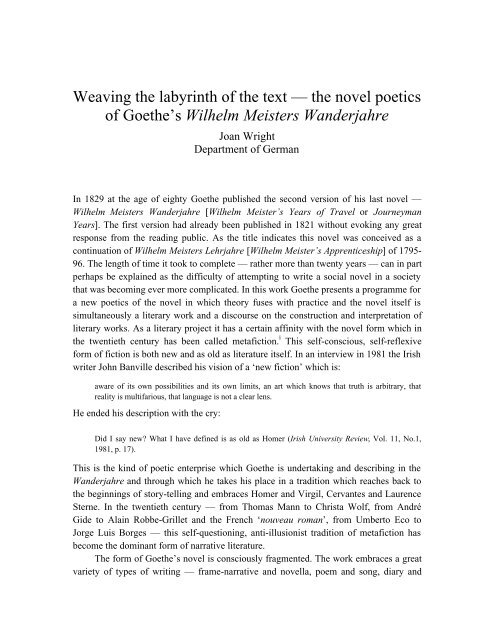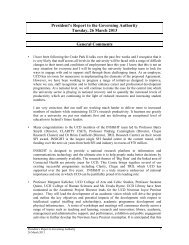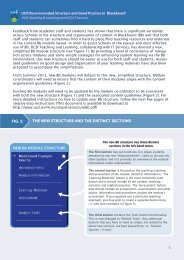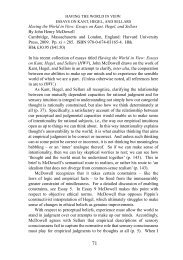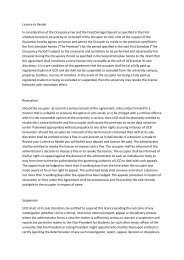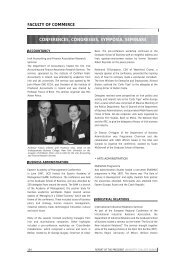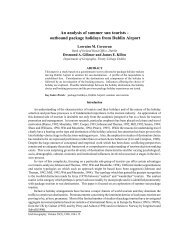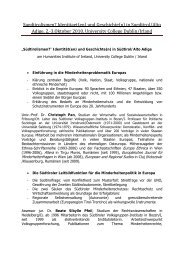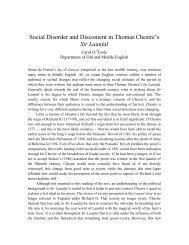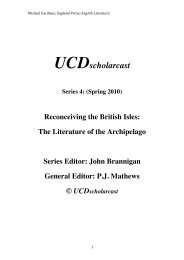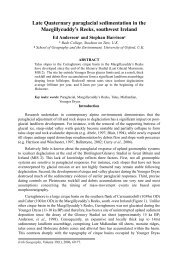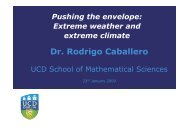Weaving the labyrinth of the text — the novel poetics of Goethe's ...
Weaving the labyrinth of the text — the novel poetics of Goethe's ...
Weaving the labyrinth of the text — the novel poetics of Goethe's ...
You also want an ePaper? Increase the reach of your titles
YUMPU automatically turns print PDFs into web optimized ePapers that Google loves.
<strong>Weaving</strong> <strong>the</strong> <strong>labyrinth</strong> <strong>of</strong> <strong>the</strong> <strong>text</strong> <strong>—</strong> <strong>the</strong> <strong>novel</strong> <strong>poetics</strong><br />
<strong>of</strong> Goe<strong>the</strong>’s Wilhelm Meisters Wanderjahre<br />
Joan Wright<br />
Department <strong>of</strong> German<br />
In 1829 at <strong>the</strong> age <strong>of</strong> eighty Goe<strong>the</strong> published <strong>the</strong> second version <strong>of</strong> his last <strong>novel</strong> <strong>—</strong><br />
Wilhelm Meisters Wanderjahre [Wilhelm Meister’s Years <strong>of</strong> Travel or Journeyman<br />
Years]. The first version had already been published in 1821 without evoking any great<br />
response from <strong>the</strong> reading public. As <strong>the</strong> title indicates this <strong>novel</strong> was conceived as a<br />
continuation <strong>of</strong> Wilhelm Meisters Lehrjahre [Wilhelm Meister’s Apprenticeship] <strong>of</strong> 1795-<br />
96. The length <strong>of</strong> time it took to complete <strong>—</strong> ra<strong>the</strong>r more than twenty years <strong>—</strong> can in part<br />
perhaps be explained as <strong>the</strong> difficulty <strong>of</strong> attempting to write a social <strong>novel</strong> in a society<br />
that was becoming ever more complicated. In this work Goe<strong>the</strong> presents a programme for<br />
a new <strong>poetics</strong> <strong>of</strong> <strong>the</strong> <strong>novel</strong> in which <strong>the</strong>ory fuses with practice and <strong>the</strong> <strong>novel</strong> itself is<br />
simultaneously a literary work and a discourse on <strong>the</strong> construction and interpretation <strong>of</strong><br />
literary works. As a literary project it has a certain affinity with <strong>the</strong> <strong>novel</strong> form which in<br />
<strong>the</strong> twentieth century has been called metafiction. i This self-conscious, self-reflexive<br />
form <strong>of</strong> fiction is both new and as old as literature itself. In an interview in 1981 <strong>the</strong> Irish<br />
writer John Banville described his vision <strong>of</strong> a ‘new fiction’ which is:<br />
aware <strong>of</strong> its own possibilities and its own limits, an art which knows that truth is arbitrary, that<br />
reality is multifarious, that language is not a clear lens.<br />
He ended his description with <strong>the</strong> cry:<br />
Did I say new? What I have defined is as old as Homer (Irish University Review, Vol. 11, No.1,<br />
1981, p. 17).<br />
This is <strong>the</strong> kind <strong>of</strong> poetic enterprise which Goe<strong>the</strong> is undertaking and describing in <strong>the</strong><br />
Wanderjahre and through which he takes his place in a tradition which reaches back to<br />
<strong>the</strong> beginnings <strong>of</strong> story-telling and embraces Homer and Virgil, Cervantes and Laurence<br />
Sterne. In <strong>the</strong> twentieth century <strong>—</strong> from Thomas Mann to Christa Wolf, from André<br />
Gide to Alain Robbe-Grillet and <strong>the</strong> French ‘nouveau roman’, from Umberto Eco to<br />
Jorge Luis Borges <strong>—</strong> this self-questioning, anti-illusionist tradition <strong>of</strong> metafiction has<br />
become <strong>the</strong> dominant form <strong>of</strong> narrative literature.<br />
The form <strong>of</strong> Goe<strong>the</strong>’s <strong>novel</strong> is consciously fragmented. The work embraces a great<br />
variety <strong>of</strong> types <strong>of</strong> writing <strong>—</strong> frame-narrative and <strong>novel</strong>la, poem and song, diary and
letter, factual and scientific report, collections <strong>of</strong> aphorisms and maxims. The ending<br />
remains open <strong>—</strong> <strong>the</strong> last words are “ist fortzusetzen” [to be continued]. Goe<strong>the</strong> was<br />
attempting, in <strong>the</strong> open form and <strong>the</strong> variety <strong>of</strong> perspectives, to reproduce in a literary<br />
work an analogy for <strong>the</strong> infinity and diversity <strong>of</strong> life itself. All aspects <strong>of</strong> life find <strong>the</strong>ir<br />
reflection in this <strong>novel</strong>: <strong>the</strong> life <strong>of</strong> <strong>the</strong> individual with its experience <strong>of</strong> <strong>the</strong> joys and pains<br />
<strong>of</strong> love; and also <strong>the</strong> concerns <strong>of</strong> <strong>the</strong> larger community, which in <strong>the</strong> early nineteenth<br />
century included <strong>the</strong> beginnings <strong>of</strong> industrialisation and job-specialisation, emigration<br />
and <strong>the</strong> search for a new life and a new social order.<br />
The eponymous hero, Wilhelm, and along with him <strong>the</strong> reader, makes his way<br />
through a series <strong>of</strong> <strong>labyrinth</strong>ine social models. In <strong>the</strong> diverse world-views he is <strong>of</strong>fered a<br />
variety <strong>of</strong> confusing possibilities which contradict and relativise each o<strong>the</strong>r. The author’s<br />
intention is not to <strong>of</strong>fer solutions to <strong>the</strong> social and o<strong>the</strong>r problems <strong>of</strong> <strong>the</strong> dawning modern<br />
age, but ra<strong>the</strong>r to challenge <strong>the</strong> reader to look for answers for himself. Through deliberate<br />
use <strong>of</strong> ambiguity Goe<strong>the</strong> aims at <strong>the</strong> education <strong>of</strong> <strong>the</strong> reader. He sets himself <strong>the</strong> complex<br />
task <strong>of</strong> giving <strong>the</strong> reader <strong>the</strong> means <strong>of</strong> developing an active, productive reading practice<br />
<strong>—</strong> a reading practice which will not only help him to interpret <strong>the</strong> written <strong>text</strong>, but also<br />
<strong>of</strong>fers him a useful metaphor for <strong>the</strong> continuous struggle to interpret <strong>the</strong> ‘<strong>text</strong>’ <strong>of</strong> his lived<br />
experience.<br />
Stylistically <strong>the</strong> work is characterised by mirroring devices which highlight its selfreflexivity.<br />
It is a technique which is described by Goe<strong>the</strong>’s own distinctive term<br />
‘wiederholte Spiegelungen’ [repeated reflections], and is akin to <strong>the</strong> device <strong>of</strong> ‘mise en<br />
abyme’ ii which is specifically associated with <strong>the</strong> French ‘nouveau roman’. The <strong>novel</strong><br />
contains within it miniature analogues for <strong>the</strong> work itself, which reflect and accentuate its<br />
narrative structure and concerns. Central to this series <strong>of</strong> reflective devices in <strong>the</strong><br />
Wanderjahre are <strong>the</strong> metaphors <strong>of</strong> <strong>the</strong> <strong>labyrinth</strong> and <strong>of</strong> weaving, which run throughout<br />
<strong>the</strong> <strong>text</strong> on <strong>the</strong> levels <strong>of</strong> content, metaphor and discourse and which are symbols both for<br />
<strong>the</strong> <strong>text</strong> itself as an artistic construct and for ways <strong>of</strong> pursuing its meaning. Both <strong>the</strong>se<br />
images are made explicit in a central passage within <strong>the</strong> <strong>the</strong> <strong>novel</strong> which <strong>—</strong> as Terry<br />
Eagleton has said <strong>of</strong> modernist literary works in general <strong>—</strong> “lays bare <strong>the</strong> device” <strong>of</strong> <strong>the</strong><br />
work’s composition (Eagleton, 1983, p. 170). The narrator says <strong>of</strong> his characters:<br />
Erwarten wir also zunächst, einen nach dem andern, sich verflechtend und entwindend, auf<br />
gebahnten und ungebahnten Wegen wiederzufinden (H.A. Vol. 8, p. 244).<br />
[We can expect <strong>the</strong>m, <strong>the</strong>refore, to reappear shortly, one after <strong>the</strong> o<strong>the</strong>r, interweaving and<br />
disentwining, on well-trodden and on untrodden pathways]<br />
It could be argued that both <strong>the</strong> <strong>labyrinth</strong> and weaving have become worn-out metaphors<br />
which are so much part <strong>of</strong> <strong>the</strong> everyday currency <strong>of</strong> speech <strong>—</strong> in such phrases as <strong>the</strong><br />
‘rich tapestry <strong>of</strong> life’, for example, or ‘<strong>the</strong> <strong>labyrinth</strong> <strong>of</strong> <strong>the</strong> world’ <strong>—</strong> that <strong>the</strong>y have long<br />
since ceased to have any figurative potency. It is perhaps ra<strong>the</strong>r <strong>the</strong> case, however, that<br />
<strong>the</strong>y are archetypal metaphors which retain <strong>the</strong>ir potency precisely because <strong>the</strong>y are so
universal. The primordial image for human life is <strong>the</strong> image <strong>of</strong> <strong>the</strong> fates <strong>—</strong> Lachesis,<br />
Clotho and Atropos <strong>—</strong> spinning, measuring and cutting <strong>the</strong> thread <strong>of</strong> life, as described by<br />
Plato in Book 10 <strong>of</strong> <strong>the</strong> Republic, in <strong>the</strong> Myth <strong>of</strong> Er (Plato, 1974, p. 451). The metaphors<br />
have gained a new resonance today with <strong>the</strong> development <strong>of</strong> <strong>the</strong> communications<br />
<strong>labyrinth</strong> <strong>of</strong> <strong>the</strong> Internet and <strong>the</strong> World Wide Web.<br />
Both <strong>the</strong> <strong>labyrinth</strong> and weaving are metaphors used since time immemorial to<br />
describe <strong>the</strong> written <strong>text</strong>. The word <strong>text</strong> itself is derived from <strong>the</strong> Latin word ‘texere’ [to<br />
weave]. In Ovid’s Metamorphoses weaving and storytelling are brought toge<strong>the</strong>r<br />
explicitly as A<strong>the</strong>ne and Arachne vie with each o<strong>the</strong>r to prove who is <strong>the</strong> better weaver<br />
and each weaves tales <strong>of</strong> human and divine transformation into <strong>the</strong> fabric <strong>of</strong> her tapestry:<br />
illic et lentum filis inmittitur aurum,<br />
et vetus in tela deducitur argumentum.<br />
[Pliant gold thread, too, was interwoven<br />
as old stories were pictured on <strong>the</strong> looms] iii<br />
In a letter to Wilhelm von Humboldt in 1832 Goe<strong>the</strong> described <strong>the</strong> metaphor <strong>of</strong> weaving<br />
as: “ein Gleichnis das ich so gerne brauche” [an image that I very much like to use]<br />
(H.A. Letters, Vol. 4, p. 136). In <strong>the</strong> Wanderjahre weaving is both part <strong>of</strong> <strong>the</strong> contents <strong>of</strong><br />
<strong>the</strong> <strong>novel</strong>, in <strong>the</strong> scenes describing <strong>the</strong> effects <strong>of</strong> industrialisation on <strong>the</strong> cottage industry<br />
<strong>of</strong> spinning and weaving in <strong>the</strong> Swiss mountains; and a metaphor for <strong>the</strong> way in which<br />
<strong>the</strong> <strong>novel</strong> itself is constructed. Commenting on this section <strong>of</strong> <strong>the</strong> <strong>novel</strong> Goe<strong>the</strong> described<br />
his concern that this weaving toge<strong>the</strong>r <strong>of</strong> heterogeneous elements should prove effective:<br />
Besonders erfreut mich, daß Sie durch unmittelbare Anschauung der Wirklichkeit meinen Webern<br />
und Spinnern günstig geworden. Denn ich war immer in Sorge, ob nicht diese Verflechtung des<br />
streng-trockenen Technischen mit äs<strong>the</strong>tisch-sentimentalen Ereignissen gute Wirkung hervorbringen<br />
könne (H.A. Vol. 8, p. 524).<br />
[I am especially pleased that direct observation <strong>of</strong> <strong>the</strong> reality caused you to be favourably disposed<br />
towards my spinners and weavers. For I was always concerned whe<strong>the</strong>r this interweaving <strong>of</strong> strictly<br />
scientific technical elements with elements <strong>of</strong> an aes<strong>the</strong>tic and emotional nature could create a good<br />
effect.]<br />
The idea <strong>of</strong> <strong>the</strong> <strong>text</strong> as an intricately woven fabric has been closely related since ancient<br />
times to <strong>the</strong> idea <strong>of</strong> <strong>the</strong> <strong>text</strong> as a <strong>labyrinth</strong>. In <strong>the</strong> Aeneid Virgil uses <strong>the</strong> metaphor <strong>of</strong> <strong>the</strong><br />
<strong>labyrinth</strong> <strong>of</strong> Crete with its “iter <strong>text</strong>um” [woven path] (Book 5, line 589), thus illustrating<br />
how both elements are contained in <strong>the</strong> archetypal myth which is <strong>the</strong> origin <strong>of</strong> <strong>the</strong><br />
metaphor: <strong>the</strong> story <strong>of</strong> Daedalus and Theseus and <strong>of</strong> Ariadne whose thread guided<br />
Theseus safely through <strong>the</strong> intricacies <strong>of</strong> <strong>the</strong> Cretan <strong>labyrinth</strong>. The tracery <strong>of</strong> <strong>the</strong> thread,<br />
<strong>the</strong> spider’s web, <strong>the</strong> woven fabric, <strong>the</strong> network <strong>of</strong> pathways in <strong>the</strong> <strong>labyrinth</strong> all create a<br />
spatial pattern which both represents and transforms <strong>the</strong> temporal linear nature <strong>of</strong> <strong>the</strong><br />
narrated word.
The <strong>labyrinth</strong> has long been used as a metaphor for <strong>the</strong> difficult <strong>text</strong> or discussion:<br />
both in a pejorative sense to denote arguments which were unnecessarily complicated;<br />
and positively for <strong>the</strong> dialectic by which <strong>the</strong> wise teacher leads <strong>the</strong> student through <strong>the</strong><br />
necessarily winding paths towards knowledge and understanding. In <strong>the</strong> Middle Ages <strong>the</strong><br />
term ‘Aristotle’s <strong>labyrinth</strong>’ was used to denote a difficult philosophical <strong>text</strong>. Goe<strong>the</strong>, too,<br />
uses <strong>the</strong> image in this sense. In an essay he describes how, when he began to read Kant’s<br />
Kritik der reinen Vernunft he experienced for <strong>the</strong> first time <strong>the</strong> attraction <strong>of</strong> a <strong>the</strong>oretical<br />
work, but never<strong>the</strong>less felt unable to enter fully into <strong>the</strong> <strong>labyrinth</strong> <strong>of</strong> <strong>the</strong> <strong>text</strong>:<br />
... nun aber schien zum erstenmal eine Theorie mich anzulächeln. Der Eingang war es der mir gefiel,<br />
in’s Labyrinth selbst konnt’ ich mich nicht wagen (W.A. 2.11, p. 49).<br />
[... now for <strong>the</strong> first time, however, a <strong>the</strong>ory seemed to smile invitingly at me. It was <strong>the</strong> entrance<br />
that attracted me, but I didn’t dare to venture into <strong>the</strong> <strong>labyrinth</strong> itself.]<br />
Both <strong>the</strong> <strong>labyrinth</strong> and <strong>the</strong> intricately woven fabric are ambivalent images, suggesting<br />
both order and chaos, harmony and threat. <strong>Weaving</strong> can create an intricate ordered whole<br />
out <strong>of</strong> a multitude <strong>of</strong> threads, but it can also create a net, a web to entrap <strong>the</strong> unwary. The<br />
<strong>labyrinth</strong> is a motif which has had an incomparable fascination for artists and writers<br />
from ancient times to <strong>the</strong> present day. It is at one and <strong>the</strong> same time a symbol <strong>of</strong> chaos<br />
and a symbol <strong>of</strong> cosmos. On <strong>the</strong> one hand <strong>the</strong> <strong>labyrinth</strong>-walker runs <strong>the</strong> risk <strong>of</strong> losing<br />
himself in <strong>the</strong> tortuous meandering paths <strong>of</strong> <strong>the</strong> <strong>labyrinth</strong>. It symbolises both <strong>the</strong><br />
subjective confusions inside <strong>the</strong> human mind and also <strong>the</strong> difficult path through <strong>the</strong><br />
objectively existing world around. On <strong>the</strong> o<strong>the</strong>r hand <strong>the</strong> <strong>labyrinth</strong> represents a complex<br />
order in diversity <strong>—</strong> a cosmos, for those who view it from outside, from a bird’s eye<br />
perspective. Both <strong>the</strong>se aspects <strong>of</strong> <strong>the</strong> <strong>labyrinth</strong>, as chaos and as cosmos, are used<br />
frequently by Goe<strong>the</strong> throughout his writings. Looking back in 1821 over <strong>the</strong> previous<br />
sixty years he uses <strong>the</strong> image in a satirical epigram to describe <strong>the</strong> increasing<br />
complexities <strong>of</strong> <strong>the</strong> world he inhabits:<br />
Seit sechzig Jahren seh’ ich gröblich irren<br />
Und irre derb mit drein;<br />
Da Labyrin<strong>the</strong> nun das Labyrinth verwirren,<br />
Wo soll euch Ariadne sein? (W.A. 3, p. 253).<br />
[For sixty years I’ve watched as all went far astray<br />
And have myself strayed with <strong>the</strong> rest;<br />
Since <strong>labyrinth</strong>s without end confuse <strong>the</strong> <strong>labyrinth</strong>,<br />
Where will we find a new Ariadne?]<br />
In his autobiographical work Dichtung und Wahrheit he suggests that literature can<br />
<strong>of</strong>fer its readers <strong>the</strong> possibility <strong>of</strong> <strong>the</strong> bird’s eye perspective which makes cosmos out <strong>of</strong><br />
chaos:
Wie ein Luftballon hebt sie uns mit dem Ballast, der uns anhängt, in höhere Regionen und läßt die<br />
verwirrten Irrgänge der Erde in Vogelperspektive vor uns entwickelt daliegen (H.A. Vol. 9, p. 144).<br />
[Like a hot-air balloon it raises us, with all <strong>the</strong> ballast that we carry with us, into higher regions and<br />
allows us from a bird’s-eye perspective to see <strong>the</strong> pattern in <strong>the</strong> confused pathways <strong>of</strong> <strong>the</strong> world<strong>labyrinth</strong>.]<br />
The ambivalent aspects <strong>of</strong> <strong>the</strong> <strong>labyrinth</strong> are also part <strong>of</strong> <strong>the</strong> imagery <strong>of</strong> <strong>the</strong> Wanderjahre.<br />
One <strong>of</strong> <strong>the</strong> embedded <strong>novel</strong>las, a vivid and fragmentary evocation <strong>of</strong> <strong>the</strong> disintegration <strong>of</strong><br />
a marriage, is introduced with <strong>the</strong> sentence:<br />
Bis tief in die Nacht blieb man zusammen und verwickelte sich immer unentwirrbarerin die<br />
Labyrin<strong>the</strong> menschlicher Gesinnungen und Schicksale (H.A. Vol. 8, p. 393).<br />
[They stayed toge<strong>the</strong>r until deep in <strong>the</strong> night and entangled <strong>the</strong>mselves ever more inextricably in <strong>the</strong><br />
<strong>labyrinth</strong>s <strong>of</strong> <strong>the</strong> human psyche and its predicament.]<br />
On <strong>the</strong> o<strong>the</strong>r hand Makarie, one <strong>of</strong> <strong>the</strong> major characters <strong>of</strong> <strong>the</strong> <strong>novel</strong>, is endowed with <strong>the</strong><br />
Ariadne-like capacity <strong>of</strong> helping <strong>the</strong> lost to find <strong>the</strong>ir way and disentangling <strong>the</strong><br />
entanglements <strong>of</strong> her fellow human beings precisely because “sie ins Labyrinth von oben<br />
herabsah und nicht selbst darin befangen war” (H.A. Vol. 9, p. 214) [she looked down<br />
into <strong>the</strong> <strong>labyrinth</strong> from above and was not herself entrapped in it].<br />
The last words <strong>of</strong> <strong>the</strong> Wanderjahre <strong>—</strong>’“ist fortzusetzen” [to be continued] <strong>—</strong> reflect<br />
Goe<strong>the</strong>’s idea <strong>of</strong> <strong>the</strong> infinite nature <strong>of</strong> <strong>the</strong> literary work. The kind <strong>of</strong> work <strong>of</strong> art which he<br />
undertakes in <strong>the</strong> Wanderjahre is that for which Umberto Eco has coined <strong>the</strong> term <strong>the</strong><br />
open work (Cf. Eco, 1979, pp. 62-3): a work <strong>of</strong> art or narrative form which not only<br />
denies <strong>the</strong> possibility <strong>of</strong> resolution into one ultimate meaning, but also suggests <strong>the</strong><br />
arbitrary nature <strong>of</strong> all beginnings and <strong>the</strong> impossibility <strong>of</strong> final closure, and which hands<br />
on <strong>the</strong> responsibility for continuation to <strong>the</strong> reader and interpreter. Like Eco, Goe<strong>the</strong> felt<br />
that openness was <strong>the</strong> essential quality <strong>of</strong> <strong>the</strong> work <strong>of</strong> art per se and he responded to this<br />
perception in <strong>the</strong> composition <strong>of</strong> <strong>the</strong> Wanderjahre by incorporating openness into <strong>the</strong><br />
structure and organisation <strong>of</strong> <strong>the</strong> work. It is a <strong>text</strong> which makes disclosure <strong>of</strong> <strong>the</strong> intrinsic<br />
openness <strong>of</strong> <strong>the</strong> literary work part <strong>of</strong> its aes<strong>the</strong>tic programme. The <strong>labyrinth</strong> is an<br />
apposite image for this kind <strong>of</strong> open work <strong>of</strong> art. It <strong>of</strong>fers, in a sense, <strong>the</strong> ultimate<br />
delusion. It is an artificial construct which <strong>of</strong>fers within an enclosed and limited space<br />
<strong>the</strong> illusion <strong>of</strong> unbounded and limitless motion <strong>—</strong> a metaphor <strong>of</strong> infinity encompassed by<br />
finiteness.<br />
The kaleidoscopic world <strong>of</strong> <strong>the</strong> Wanderjahre highlights many <strong>of</strong> <strong>the</strong> central issues<br />
<strong>of</strong> <strong>the</strong> early nineteenth century: <strong>the</strong> problems and opportunities <strong>of</strong> early industrialisation<br />
and technological and scientific progress; overpopulation, emigration and land-reform;<br />
educational reform and <strong>the</strong> pursuit <strong>of</strong> a system <strong>of</strong> values which can keep pace with <strong>the</strong><br />
developing complexity <strong>of</strong> <strong>the</strong> world; <strong>the</strong> growth <strong>of</strong> both religious tolerance and antisemitism;<br />
<strong>the</strong> relationship between <strong>the</strong> sciences and <strong>the</strong> arts; <strong>the</strong> increasing complexity <strong>of</strong>
human relationships and changing gender roles. The aim <strong>of</strong> <strong>the</strong> work is precisely this<br />
delineation <strong>of</strong> issues: to highlight <strong>the</strong> areas where problems might lie and to give <strong>the</strong><br />
reader and interpreter pause for thought. It is a work which recognises <strong>the</strong> value <strong>of</strong> <strong>the</strong><br />
descriptive and <strong>the</strong> limitations <strong>of</strong> <strong>the</strong> prescriptive. Its insistence that everything “bleibt im<br />
Schweben” (H.A. Vol. 8, p. 447) [hangs in <strong>the</strong> balance] points to <strong>the</strong> fundamental<br />
uncertainty and indefiniteness, not only <strong>of</strong> every act <strong>of</strong> interpretation, but also <strong>of</strong> <strong>the</strong><br />
essential human condition. That this work is to be regarded as an affirmation <strong>of</strong> <strong>the</strong><br />
problematical was underlined by Goe<strong>the</strong> when he described it as a ‘Rätsel’ [riddle] and<br />
said <strong>of</strong> it:<br />
Jede Lösung eines Problems ist ein neues Problem (Gräf, 1902, p. 976).<br />
[Every solution to a problem raises a new problem].<br />
BIBLIOGRAPHY<br />
PRIMARY SOURCES<br />
Goe<strong>the</strong>, J. W., Werke, herausgegeben im Auftrage der Großherzogin Sophie von<br />
Sachsen-Weimar, Abteilung I-IV, 1887-1919 (Weimarer Ausgabe = W.A.). English<br />
translations are by J. Wright.<br />
Goe<strong>the</strong>, J. W., Werke, edited by Erich Trunz, 14 volumes, Hamburg 1949-67 & revised<br />
edition, Munich, 1981 (Hamburger Ausgabe = H.A.). English translations are by J.<br />
Wright.<br />
Gräf, Hans Gerhard, Goe<strong>the</strong> über seine Dichtungen, 3 volumes, Frankfurt am Main,<br />
Rütten u. Loening, 1902, (rep. Darmstadt, 1968).<br />
Ovid, Metamorphoses, translated by Mary M. Innes, Harmondsworth, Penguin Classics,<br />
1971 (7).<br />
Plato, Republic, translated by Desmond Lee, Harmondsworth, Penguin Classics, 1974.<br />
Virgil, Aeneid, Oxford, 1971.<br />
SECONDARY SOURCES<br />
Dällenbach, Lucien, Le Récit spéculaire. Essai sur la mise en abyme, Paris, Seuil, 1977.<br />
Eagleton, Terry, Literary Theory. An Introduction, Oxford, Blackwell, 1983.<br />
Eco, Umberto, The Role <strong>of</strong> <strong>the</strong> Reader, Bloomington, Indiana University Press, 1979.<br />
Hutcheon, Linda, Narcissistic Narrative. The Metafictional Paradox, London & New<br />
York, Routledge, 1980.<br />
Irish University Review, a Journal <strong>of</strong> Irish Studies: John Banville Special, Volume 11,<br />
No.1, 1981.
Schmeling, Manfred, Der <strong>labyrinth</strong>ische Diskurs, Frankfurt am Main, A<strong>the</strong>näum, 1987.<br />
Waugh, Patricia, Metafiction. The Theory and Practice <strong>of</strong> Self-Conscious Fiction,<br />
London & New York, Methuen, 1984.<br />
i<br />
Metafiction has been described as “fiction that includes within itself a commentary on its own narrative<br />
and/or linguistic identity” (Hutcheon, 1981, p. 1). Patricia Waugh lists a range <strong>of</strong> characteristics which are<br />
commonly found in metafictional <strong>text</strong>s <strong>—</strong> including <strong>the</strong> obtrusive narrator, <strong>the</strong> dramatisation <strong>of</strong> <strong>the</strong> reader<br />
role, Chinese box structures, self-reflexive images (such as mirrors and mazes) and parody <strong>of</strong> literary<br />
conventions <strong>—</strong> and comments: “In all <strong>of</strong> <strong>the</strong>se what is foregrounded is <strong>the</strong> writing <strong>of</strong> <strong>the</strong> <strong>text</strong> as <strong>the</strong> most<br />
fundamentally problematic aspect <strong>of</strong> that <strong>text</strong>” (Waugh, 1984, pp. 21-2).<br />
ii<br />
‘Mise en abyme’ has been defined as “any internal mirror reflecting <strong>the</strong> narrative whole by simple,<br />
repeated or spacious reduplication” (Dällenbach, 1977, p. 52). The term originated with André Gide who<br />
derived it from <strong>the</strong> heraldic emblem <strong>of</strong> a shield in whose centre is reproduced a miniature version <strong>of</strong> itself.<br />
Gide used <strong>the</strong> device in Les Faux-Monnayeurs where <strong>the</strong> central character, Edouard, is a <strong>novel</strong>ist working<br />
on a <strong>novel</strong> with <strong>the</strong> same title as, and a strong resemblance to, <strong>the</strong> <strong>novel</strong> in which he is a character.<br />
iii<br />
Ovid, Metamorphoses, Book 6, lines 68-9. Translation: Penguin Classics, 1971, p. 136.


